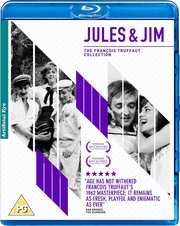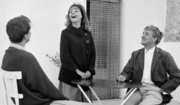Review for Jules et Jim
‘Jules et Jim’ is one of the few films that successfully captures all the spirit, passion and excitement of deep friendship. In this case, two outsider bohemians, somewhat like the American Beats, who are delighted to find in each other a sympathetic audience and someone worthy of intellectual debate and discussion. It’s almost perfect in every respect. It looks beautiful (though on occasion I ache to see the French countryside in colour), it is imaginatively and sympathetically directed, and the performances and dialogue wonderfully natural. It also looks better than ever on this stunning Blu-Ray transfer – a leap upwards from its DVD release of almost a decade ago.
The story goes that Truffaut found Henri-Pierre Roché‘s novel in a second-hand bookshop, entirely by chance, and loved its literary style. He then set about capturing what he felt was so sublimely stated in the novel in film. Indeed, according to the introduction to the film by French cinema historian Serge Toubiana, Truffaut shared notes with the aged author during pre-production, including photos of his proposed leading lady. Roche’ approved of the choice and asked to meet JeanneMoreau – but sadly died a few days after posting his reply.
Jules (Oskar Werner) is an Austrian writer who strikes up a friendship with the gregarious and charismatic Jim (Henri Serre), a Frenchman. Whilst they find much in common (they share a bohemian attitude and a passion for the arts) Jim is a confident womaniser, happy to flit between various lady friends, though Jules is more intent on finding a single lady who would become the love of his life. Cue Catherine (Jeanne Moreau), who is like no one they’ve ever met. Not only does she possess the ‘perfect smile’ that both men had so passionately admired in a Greek sculpture, but a wild, bohemian spirit full of impulse, energy and spontaneity. They both find themselves in love with her though she starts a faltering relationship with the more earnest Jules, whilst Jim continues to see a lady called Gilberte (Vanna Urbino).
Though Jules is devoted to her, she is still prone to seeing other men at the drop of a hat and continuing her wild, anything goes existence. Ironically it is exactly this that draws Jules to her and yet which he can scarcely tolerate.
The film, wildly ambitious in scope, then shows the two men divided by politics and circumstance during the Great War, fighting for opposing sides but both doing all they can to avoid any possibility of being in proximity of the other. Naturally, both find the idea of killing their friend abhorrent. Though rushed out of necessity, the ‘war’ interlude is perhaps the weakest and least convincing part of the film though it’s not long before it pulls back on track.
Catherine and Jules are now in Austria and have a daughter. When Jim visits they find they have all changed. Jim is now envious of Jules more settled lifestyle, whilst Jules despairs of the inevitability of Catherine leaving. In the meantime, Jim is still seeing Gilberte though it’s clear that he is still in love with Catherine.
It’s a tragic triangle cleverly reflecting the complexity of relationships and love where no one relationship seems to be enough.
The cinematography (Raoul Coutard) is superb throughout and there are plenty of examples of Truffaut’s inventive direction (popularly grouped with the so-called French New Wave). At only 29 when he directed this the sheer scope of his inventive direction is almost as impressive 50 years on and I’s easy to see why Truffaut remains such a heady influence today. Examples include freeze frames used on occasion for emphasis of reaction; the camera combing around at floor level as the three explore the French countryside looking for signs of civilization amongst the soil in the form of discarded matches and cigarette packets; the camera being dollied next to Catherine as she runs across a bridge giving the audience her point of view, full of energy and exuberance; or even changes in aspect ratio showing poor Jim feeling increasingly ‘boxed in’. It’s clever stuff that never gets in the way and really enhances the experience.
The score by Georges Delerue is perfect – never invasive and always sympathetic. In fact, the score is barely noticeable, fitting so well with the atmosphere of the film.
The transfer here is really impressive. Presented in original aspect ratio of 2.39:1, and encoded with MPEG-4 AVC at 1080, transferred from an almost perfect print it really is a feast for the eyes (other than the use of archival documentary footage for the war sequences which are naturally fairly gritty).
There’s a single French LPCM 2.0 (Mono) audio track with clear and precise English subtitling on demand – essential actually as sometimes the dialogue moves quickly, particularly early on when the narrator is setting the scene in an almost breathless rush.
Extras include a 4 minute trailer, a brief introductory presentation from Serge Toubiana, president of Cinémathèque française, who audibly introduces the film with some historic context and critique in the form of stills. Perhaps most welcome is the Jeanne Moreau commentary recorded in 2000 by Serge Toubiana which is a fascinating piece, reflecting Truffaut’s style through the eyes of the film’s real lead. (Note: This is the same commentary as appears on the Criterion Blu-Ray release of the film, though that edition does include an older and arguably less satisfying transfer of the film).
Though some may criticize the ‘Jules et Jim’ for glorifying dilettantism above all, despite the duplicity and selfishness that this sometimes involves, it remains, in my view, a rare treasure in capturing three entangled lives so fully in such a short space of time. In this regard, it must be viewed as a major cinematic achievement regardless of how fully you do or don’t sympathise with its leads. Highly recommended – and this edition is probably the best yet.

























Your Opinions and Comments
Be the first to post a comment!